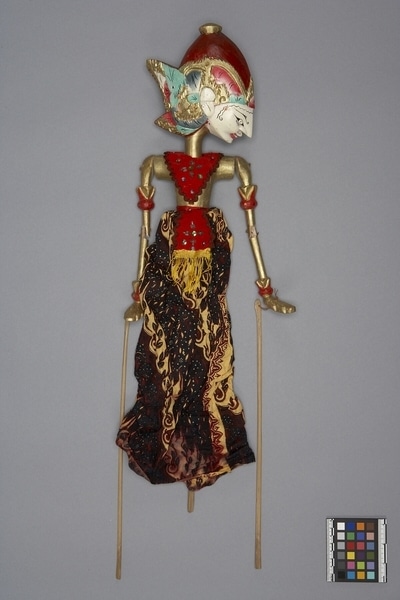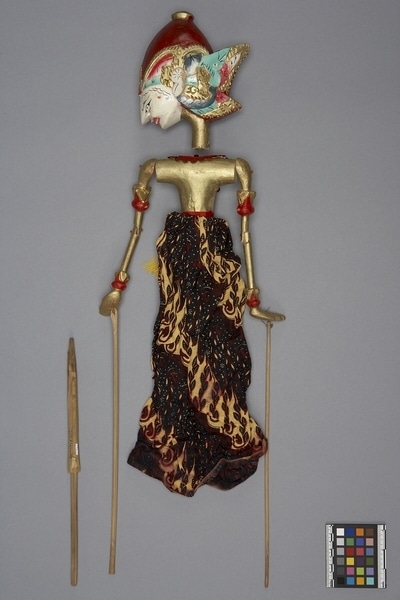Rod Puppet Item Number: Ib405 a-c from the MOA: University of British Columbia


Description
Three-dimensional male humanoid puppet: large head (part b) fits into body with skirt (part a), and a control rod (part c) with a long shaft that passes through the body and fits into the neck of the figure's head. The body has jointed arms, each with a long controlling rod attached. White face positioned downwards: straight, pointed nose, red lips, white teeth. Eyes, hair, moustache, outlined in black. Wide red crown (mahkota) headdress with large gold diadem and karawista. Green Garuda Mungkur (long tongue) with floral (?) design. Green and grey trim. Neck and upper torso gold; pair of gold and red ornaments on each arm at wrist and bicep. Hands held flat and bent back at wrist. Red chest covering and apron with beads and sequins; apron has red waistband and yellow fringe at bottom. Batik in red and blue on rough beige cloth for skirt.
History Of Use
Javanese puppetry as an art form probably developed by the 11th century. Wayang golek puppets of western Java appeared during the 16th century. Originally the plays depicted Javanese mythology, but after the Indian conquest of Java the Hindu epics, Ramayana and Mahabharata, were incorporated into the cycles, which comprise about 200 plays. A dalang (puppet master) performs the plays to celebrate important occasions, usually in three acts, with vocal and instrumental accompaniment. Typically they serve a moral and religious purpose, and more recently, one of political commentary. Kama is found in Pandalarang and Cipanas. He can be found in the roles of some quite different gods, or may even be disguised as Arjuna or Karna. He is known as the son of Semar, thus continuing the Javan mythology incorporated into the Hindu myths. He is found in all cycles. Shiva is the head of the Hindu pantheon, and considered the brother of Semar. He also appears in all cycles. This puppet may be used for either role.
Iconographic Meaning
Each puppet is characterized by its wanda, a Javanese word which describes the specific mixture of elements of size, form, colour, ornamentation and carving. Position and colour of face suggest high virtue; delicate facial features are very refined. Position of hands, arm ornaments, colour of skin, and particularly headdress indicate very high nobility (king or god). Long tongued Garuda on headdress identifies character as Kama or Shiva, although some variations exist.
Cultural Context
Theatrical performance.
Item History
- Made in Java, Indonesia
- Owned by Donald Bone before January 4, 1980
- Received from Donald Bone (Seller) and Museum of Anthropology Donations Fund (Funding source) on January 4, 1980
What
- Name
- Rod Puppet
- Identification Number
- Ib405 a-c
- Type of Item
- puppet
- Material
- wood, fibre, paint and cotton fibre
- Manufacturing Technique
- carved, woven, sewn, painted and tied
- Part B
- height 18.0 cm, width 8.5 cm, depth 16.0 cm
- Part A
- height 58.5 cm, width 18.0 cm, depth 6.5 cm
- Part C
- height 33.0 cm, width 1.5 cm, depth 1.5 cm
Who
- Culture
- Sundanese
- Previous Owner
- Donald Bone
- Received from
- Donald Bone (Seller) and Museum of Anthropology Donations Fund (Funding source)
Where
- Holding Institution
- MOA: University of British Columbia
- Made in
- Java, Indonesia
When
- Ownership Date
- before January 4, 1980
- Acquisition Date
- on January 4, 1980
Other
- Condition
- fair
- Accession Number
- 0586/0025 a-c